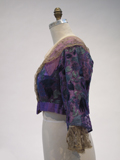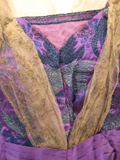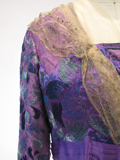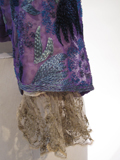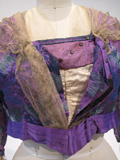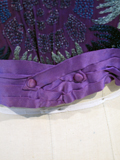This purple embroidered and beaded silk chiffon and charmeuse bodice with a lace fichu can be dated c. 1912. The label, in German, translated says it is from "Bergmann of Munich, Germany."
Description

The bodice is made of complimentary silk chiffon and charmeuse which has been embroidered and beaded. It was probably part of an elaborate afternoon frock or evening gown worn prior to World War I. 1912 is the midpoint for dating the bodice; both written and pictorial research shows it could be dated between 1910 and 1914.
It was likely meant to be worn as an afternoon frock or evening gown. At that time, both these garments were described as having a classical Empire silhouette, with a simple, loose cut and a thick waist. Gowns for these purposes were made from layers of lace, embroidered and beaded chiffon and silk. These bodices are also described as having low "V" shaped neckline.
The bodice was made by Bergmann in Munich, Germany, as noted on the label on the grosgrain inner belt.
Figure 2: Source Label |
 |
The company was researched but found only the existence of a man named Ludwig Bergmann, "a German clothing manufacturer" who died in 1932.
General Information
The bodice is primarily stitched by machine. However all finishing work is hand sewn, as is the application of the outer bodice to the inner foundation. The bodice consists of a built in bodice protector, resembling a chemise, of cream cotton batiste and inner bodice of cream, light weight silk satin. The outer bodice is primarily made of embroidered and beaded purple silk charmeuse.
The embroidery and beading has been applied by machine. The embroidery consists of abstract shapes, created by a chain stitch, in three shades of blue and the beading is floral shaped in varying shades of purple, blue and turquoise seed beads. The paint or dye on the purple and blue beads has worn away in some places making it difficult to determine the exact shades. A yoke of solid purple silk chiffon flat lined to cream bobbin lace and cream silk chiffon, is applied both front and back. The inner bodice closes by "kissing" center front with a series of hooks and eyes, while the outer bodice closes right over left with snaps.
Figure 3: Interior Closure |
Figure 4: Outer Closure |
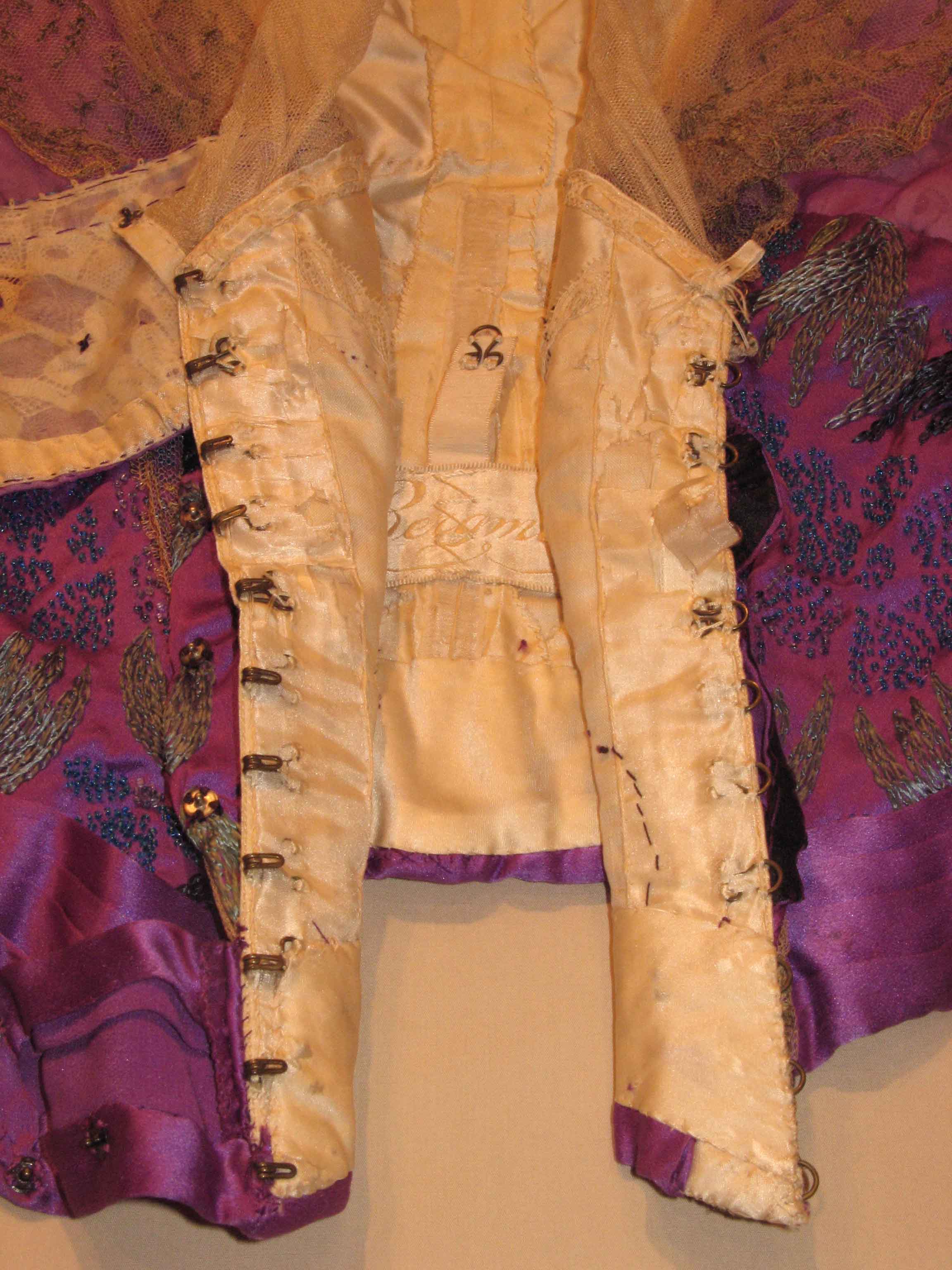 |
 |
The set in, three quarter length sleeves, consist of three layers, as well; the cream silk chiffon and cream bobbin lace of the yoke and a purple, embroidered and beaded silk chiffon. This chiffon is embroidered and beaded in the same pattern as the outer bodice satin. The front neckline dips into a fairly low "V" which is filled with a modesty panel. This panel is constructed with the same layers of fabric as the yoke.
Figure 5: Fabric Detail |
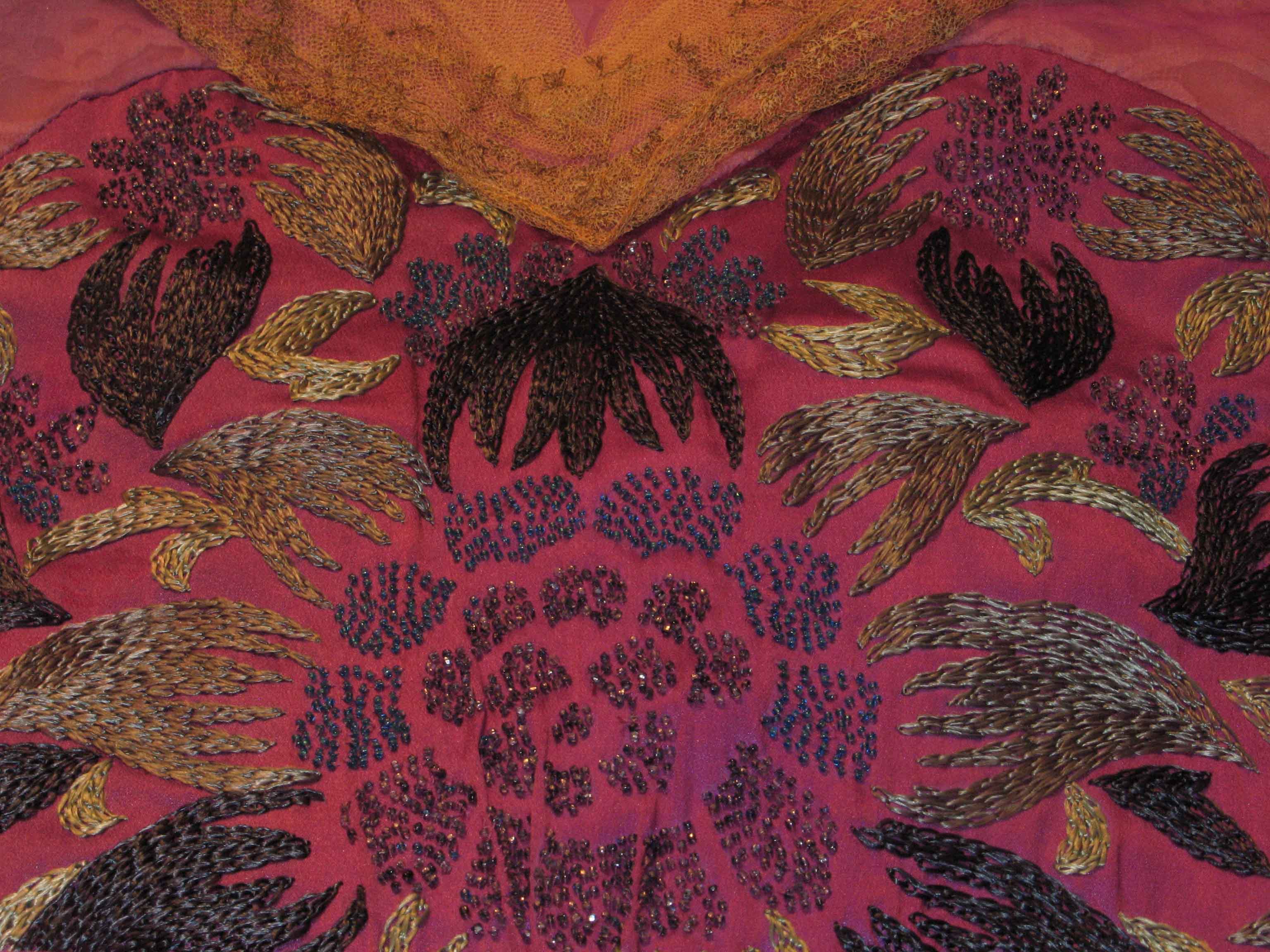 |
It is trimmed with an applied strip of embroidery and beading, believed to be the finished edge of the complimenting chiffon. The back neckline dips on an angle on each side then straightens, creating a lowered, square neckline. The neckline is trimmed with the same applied strip of embroidery and beading as the modesty panel. However, the trim ends, in the front, at the intersection of the yoke and embroidered charmeuse. The neckline is filled in with two pieces of cream silk tulle. The bodice also has cream silk tulle, embroidered with bullion, draped from center front on a diagonal to the neckline. The tulle follows the neckline to the squared section in back, at this point the tulle continues on a diagonal to center back. At center back the tulle is mitered in a series of tucks, creating a "V" shape, and mirrors the other side to center front. The overall look of the embroidered silk tulle is that of a fichu.
Figure 6: Front Neckline |
 |
This same tulle hangs in a ruffle below the chiffon layer of the sleeve. The hem of the bodice comes to a point center front and center back and is finished with a belt.
It appears the dressmaker made some initial alterations. On the top front of each armscye, of the inner bodice, is a series of three slits that have been turned back and secured with a slip stitch.
Figure 7: Alteration Detail |
Since this bodice is a larger size, it is believed the dressmaker added these reinforced slits to compensate for a larger bust and fleshy armscye. These reinforcements are each 1/2" wide at the base and 3/4" long. The bottom leg of the first reinforcement rests 3" from the side seam. The other two are spaced 3/4" from each other, measuring the distance between outer legs. There also are small, hand sewn darts, measuring 1/2" by 2", 2 1/4" from the side seams on the front waistline.
There are other visible alterations that appear to have been made after the original construction. The side front seams have been let out, tapering to a full inch at the bust; increasing the front inner bodice 2" in the bust. A 1/2" dart extending 3" from each armscye has been released. As a result, the original position of the sleeve has been altered. The machine stitching has been removed and restitched by hand. To compensate for opening the dart, the side seams have been taken in 1/2" each. The interior belt of the inner bodice has also been taken in 1/2" on each side of center front.
The finished measurements of the bodice, as it exists today, are quite large for the period but more average for the contemporary woman. The bust measures 40" and the waist 36". This bodice would fit a size 12 dress form or today’s woman wearing a size 12-14. The waistline of this period is higher so it is important to note the armscye to waist measurement as 5 1/2". In other words, the waist measurement, 36", is above the natural waist; on the ribcage close to the diaphragm.
Inner Bodice
The inner bodice consists of 12 total pieces; two on each side of the front and four on each side of the back.
Figure 8: Interior Back |
Figure 9: Bone Casing |
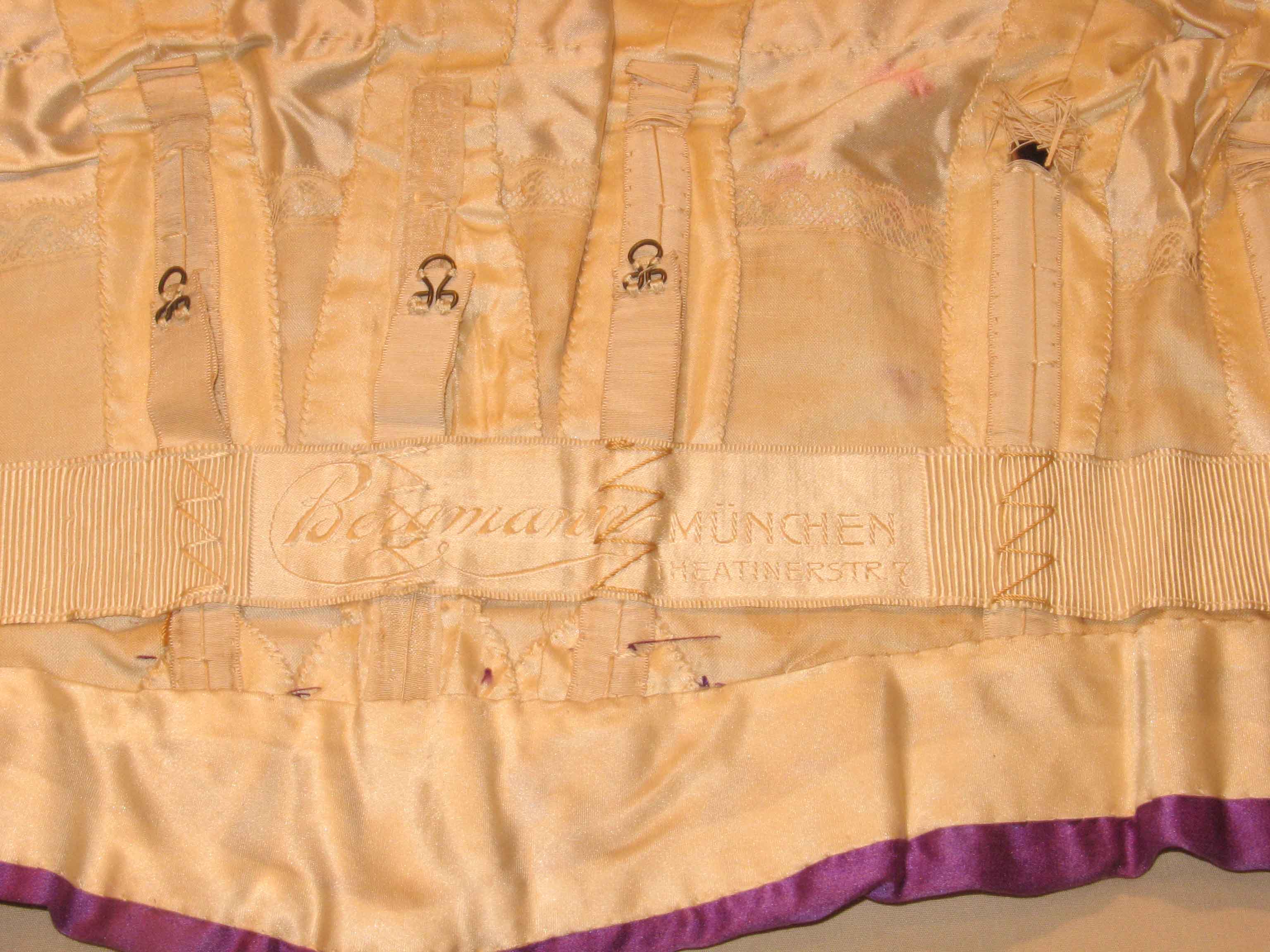 |
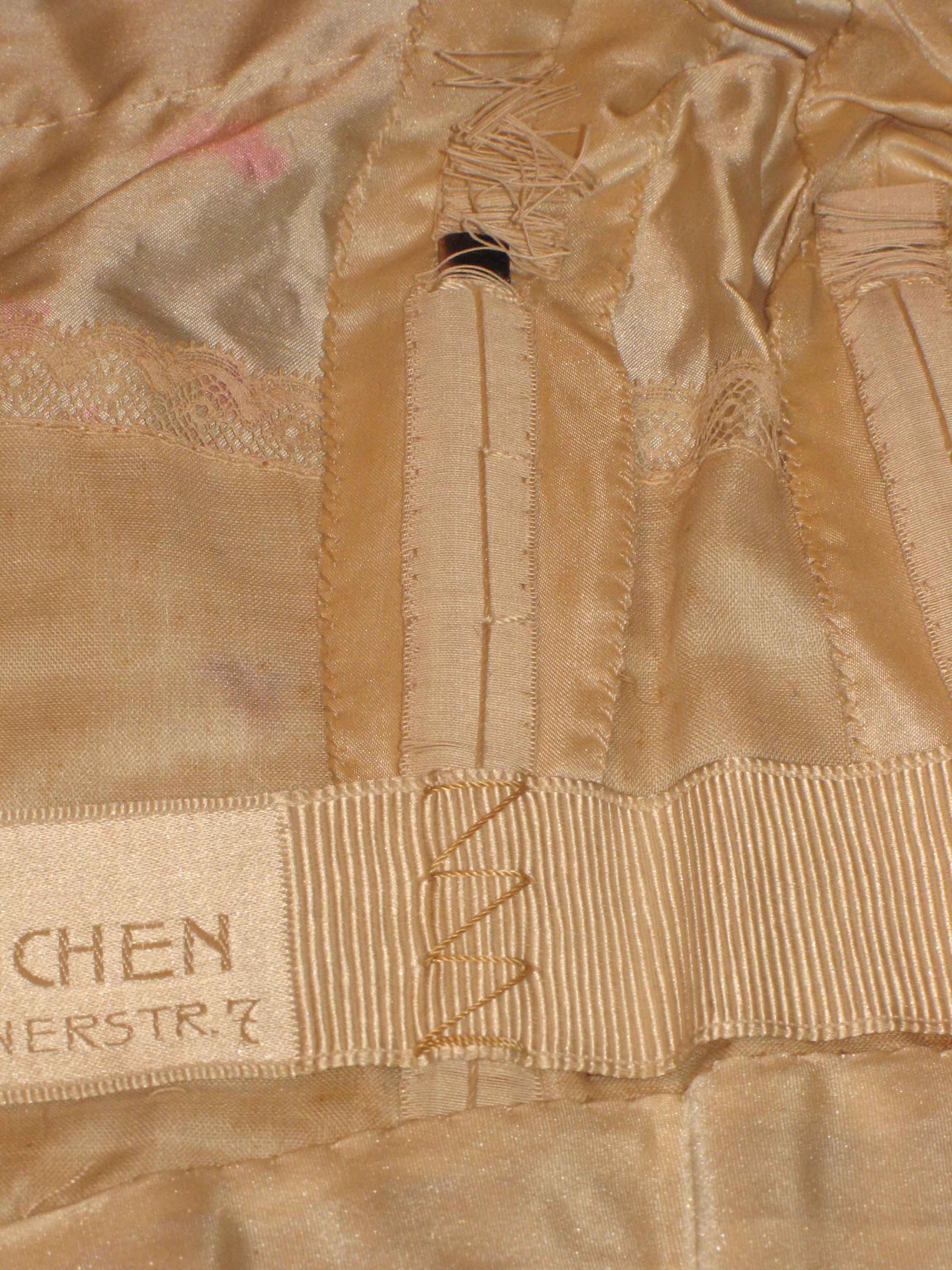 |
The chemise follows these same seam lines except that the pieces are hemmed at the bust line, dipping to 3" below the armscye, and finished with 1/2" cream lace edging. These chemise pieces are flat lined to the pieces of the inner bodice.
Figure 10: Interior Neckline |
 |
At each seam a 3/8" whale bone is encased in 1/2" cream silk ribbon. Some of the ribbon is unraveling with age. The bones progress from front to back in the following measurements: 5 1/4, 5 3/4, 5 1/2, 5 3/4, 6 1/2, and 7. The whale bones have holes in the center for sewing directly to the seam allowance. They are sewn with a heavy thread, not unlike buttonhole twist. The unaltered seam allowance measures 5/8", is opened, pressed flat and finished by hand overcastting.
The neckline follows the same lines as the outer bodice. The edge has been finished with 1/2" cream lace beading with a 1/8" cream silk ribbon running through it. The lace has been hand sewn with a running stitch then turned down, encasing the satin’s raw edge, and stitched to the inner bodice. The lace has mitered corners at the squared line of the back neckline.
There is a cream 1 1/4" silk grosgrain ribbon, with the Bergmann label woven into it, acting as an interior belt. This belt helps keep the bodice in place and gives stability to the skirt tapes. The belt is stitched 2 3/4" above the hem of the center back and at each seam across the back, 7 total, finishing 1 3/4" above the hem at the side back seam.
Figure 11: Interior Belt Closure |
 |
Skirt tapes, made of the same 1/2" silk ribbon used for bone casings, are sewn behind the interior belt at the three center back seams and the side back seam. The ribbon is doubled and measures 1 1/2" above the belt. Each tape has a steel eye sewn on the edge for attaching the skirt to the bodice. The skirt, which is missing, would have steel hooks to coordinate with the tapes.
The center front, of the inner bodice, is turned back and edge stitched, then top stitched 3/8" from the folded edge.
There is a 1/4" bone measuring 4 3/4" inside these stitching lines. The bones have a hole at the top, and presumably the bottom, for anchoring the bone to the bodice. The left front side has 11 steel eyes sewn 3/4" apart, the right has hooks, for closing. A 1" cream silk ribbon has been stitched to the inside of the front openings; covering the raw edge of the center fronts and stitching of hooks and eyes. The hem of the inner bodice is folded to the inside and catch stitched.
The interior belt has been turned back with two eyes stitched on the left and hooks on the right. The raw edge of the ribbon and stitching of hooks and eyes is finished with ribbon similar to the bone casings.
The cream silk tulle filler is sewn directly to the neckline of the inner bodice, overlapping center back. It is two rectangles cut on the bias and folded in half with a finished width of 3". At the shoulders the tulle has been folded into three 1/4" pleats, causing the net to softly pleat both front and back. Both front edges are finished on the grain with cream silk ribbon folded in half widthwise. The tulle overlaps center front, so one end of ribbon is stitched to the inner bodice and a male snap sewn to the other. Female snaps are then sewn to the front of the inner bodice to hold the filler in place.
Yoke
Cream silk chiffon, cream bobbin lace and solid purple silk chiffon have been flat lined and cut into the shape of the front and back yoke pieces.
The front yoke follows the bodice neckline from the shoulder to 3" away from center front, it then continues on a deeper diagonal ending 1 3/4" from center front. At this point the yoke squares off and goes into the armscye.
Figure 12: Yoke |
Figure 13: Neckline and Yoke |
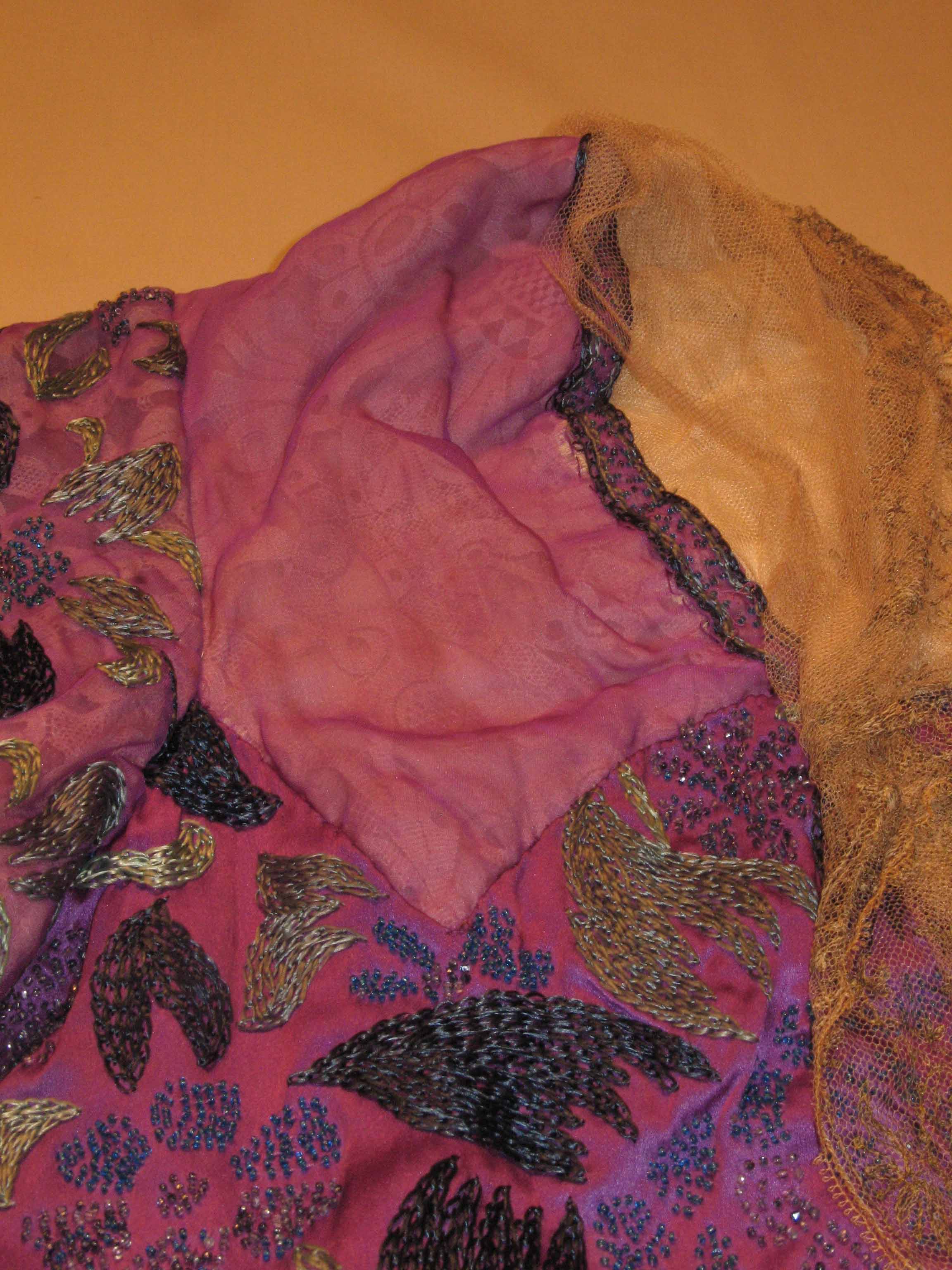 |
 |
The back yoke follows the neckline and shoulder seams of the inner bodice. It squares across 5 1/2" below the squared back neckline into the armscye. After the shoulder seams are stitched the neckline edge is turned under and sewn with a running stitch. The embroidered and beaded chiffon trim is then applied by slipstitching; the trim’s raw edges have been folded under so the neckline is completely clean.
Modesty Panel
The modesty panel is rectangular shaped, measuring 3" x 6". The panel consists of three layers: cream silk chiffon, cream bobbin lace, and solid purple silk chiffon. The sides have been turned back 1/4" twice and slipstitched. The right side is sewn with a running stitch to the inner bodice, at the intersection of the yoke and neckline, and the outer bodice. There are five male snaps, spaced evenly, on the left wrong side coordinating with female snaps on the outside of the inner bodice. The top and bottom edges of the two chiffon layers are turned into each other 1/4". The lace is simply cut straight and the two layers of chiffon are prick stitched together. For extra stability, the ribbon used for bone casings has been sewn using a running stitch to the bottom edge, beyond where the panel is stitched to the outer bodice.
Sleeves
The sleeves consist of three layers, as well; cream silk chiffon, cream bobbin lace and purple embroidered and beaded silk chiffon. The bobbin lace is divided into three parts; two 3" wide strips backstitched together, through the chiffon flat lining as well, and a solid piece of the lace. The solid piece ends 8" down from the sleeve cap. The cream chiffon and lace have been flat lined, seamed together, finished by hand overcastting and pressed to the back. At the hem, a 3 1/2" ruffle, of cream, bullion embroidered, silk tulle, has been stitched. All layers are then folded 1/4" twice and slipstitched to the cream chiffon. A 1/4" cream insertion lace is prick stitched at the hem to blend the transition from one lace to the other. The ruffle is tacked up on the center front hem of the sleeve.
The purple embroidered and beaded chiffon is seamed separately and the seam allowance is finished the same as the other layer. The hem is turned up, on the outside, 1/4" and a strip of embroidered only chiffon trim is applied.
The trim’s top raw edge has been turned in 1/4" and slipstitched to the outside of the sleeve. The bottom edge is turned 1/4" twice and slipstitched to the inside of the sleeve. The two sleeve layers are randomly tacked together at the hem. At the armscye, the layers are machine stitched to the bodice, trimmed to 1/4" and hand overcast.
Figure 14: Inner Sleeve |
Figure 15: Outer Sleeve |
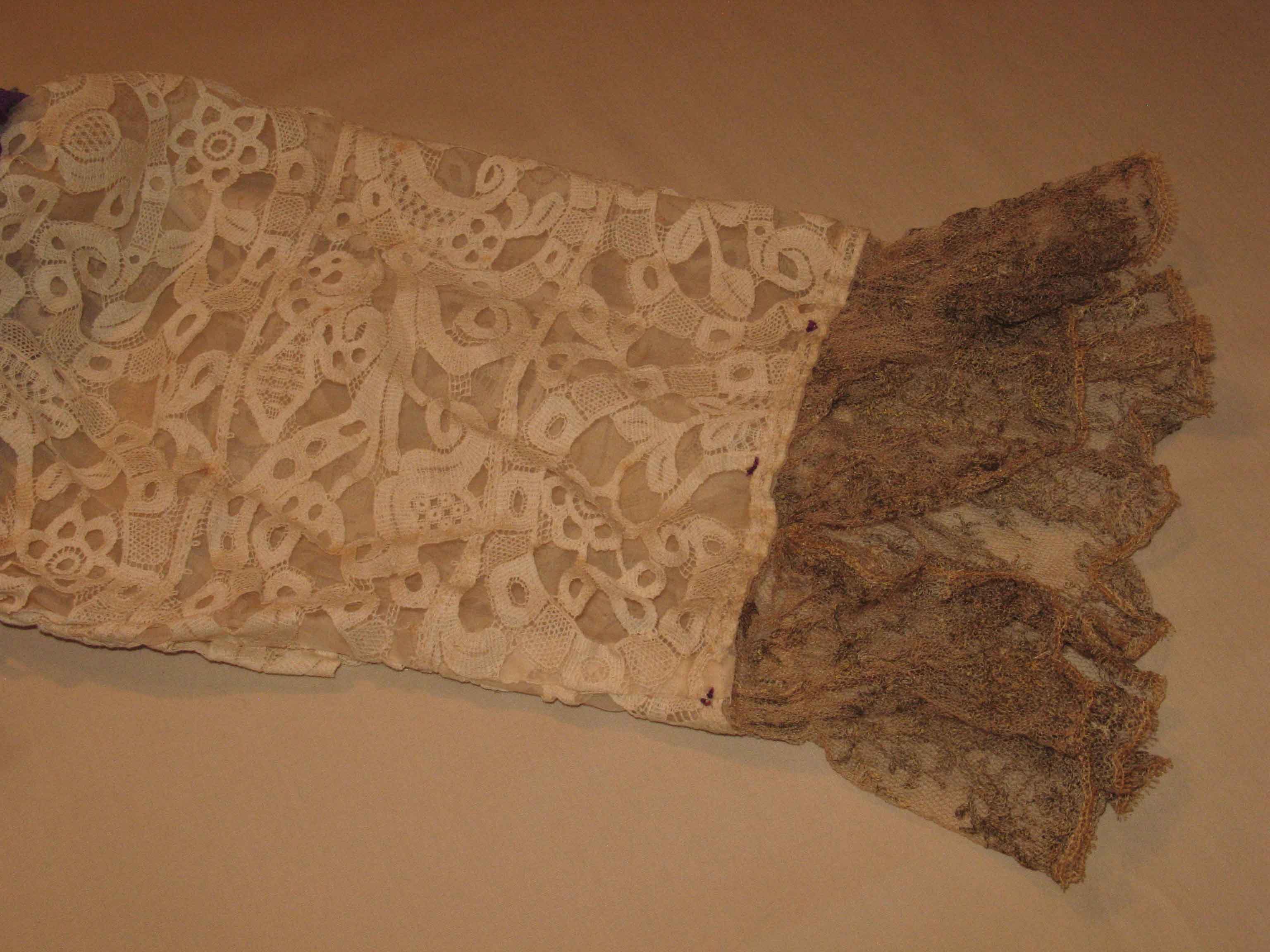 |
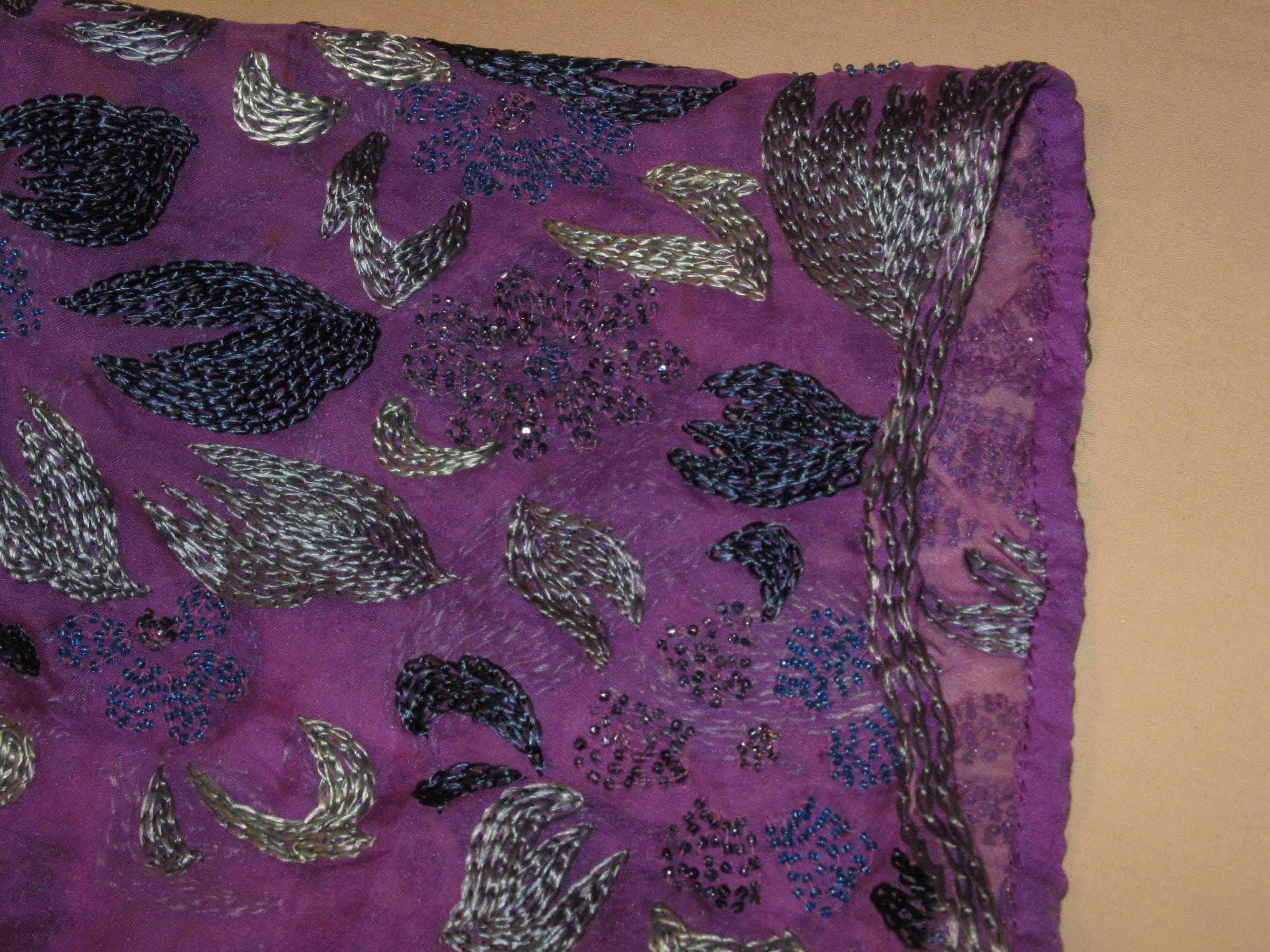 |
Outer bodice
The outer bodice, of purple embroidered and beaded silk charmeuse, is cut with center back on grain. It is clear this was planned to feature a definite embroidered and beaded pattern.
Figure 16: Front Bodice Detail |
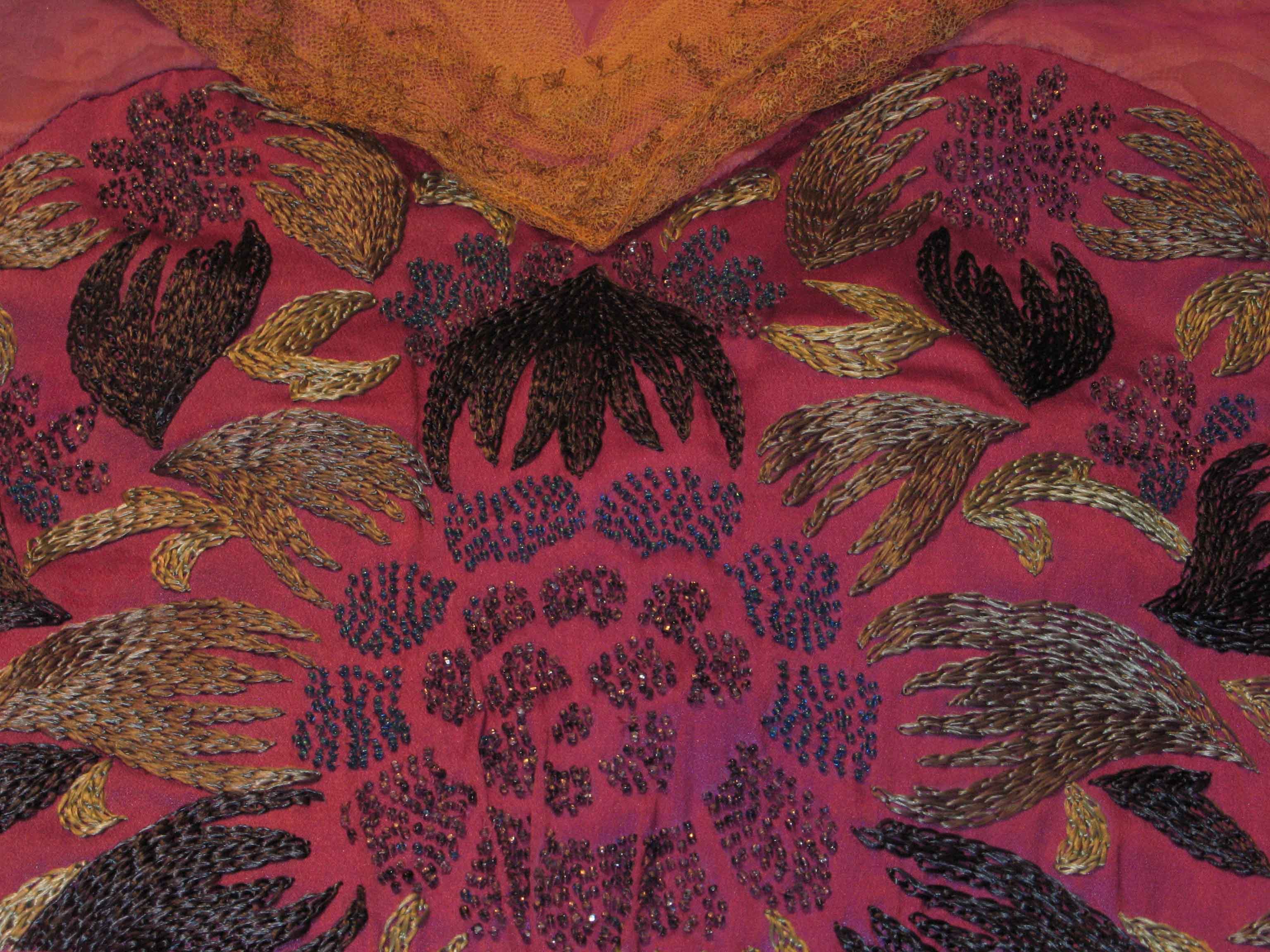 |
There are no side seams only a dart, slipstitched, along this line. In other words, the outer bodice is cut in one piece and measures the width of the fabric. The center back top edge is folded into a point, the same point as the fichu, 4 3/4" below the squared neckline. From this point, the edge continues to fold into a curved pattern similar to a heart shape. It comes to a point 1 1/2" from the armscye and angles back up in a diagonal, disappearing into the armscye. This folded edge is then slipstitched to the purple chiffon of the yoke.
The bodice front, top edge, is folded under at the armscye about 3/4" below the point where the back disappears into the armscye. It then angles down on a diagonal to a point even with the armscye and 4 1/2" away. The edge continues to fold under in a half circle shape to center front and a point even with the armscye. This top edge is then slipstitched like the back.
The right front side is stitched to the modesty panel where it joins with the yoke. To resolve the left front, which is not stitched to the modesty panel, the top edge is finished with a 1/2" strip of purple charmeuse slipstitched to the outer bodice.
Four, evenly spaced, male snaps are sewn on to hold this edge in place. Four coordinating female snaps are sewn to the modesty panel. The right front edge is turned back 1/2" twice, encasing the selvage. Four evenly spaced male snaps are sewn 1/8" in from the folded edge. The left front edge is turned back 1/4", on the selvage, and finished with 3/8" black hem tape.
Belt
The belt is made of purple silk charmeuse cut on the bias. The charmeuse is draped into four 3/8" pleats with a finished width of 1 1/2". The left side finishes 3/4" from center front by folding back 1/4". The right side ends center front but has been seamed to an extension piece. The pleats are cheveroned along this seam line. The seam allowance of the belt is finished by turning back and is whip stitched to the center front of the inner bodice. The seam allowance of the extension is over cast. Both the top and bottom edges are folded to the inside 1/8" then 1/2". The top edge is left loose while the bottom has been slipstitched. 3/4" away from the end of the extension, the top and bottom are both folded in to create a point. To finish the folded sections, a triangular piece of charmeuse has been slipstitched to the extension. There are three male snaps, following the shape of the triangular piece, to hold the belt in place as it overlaps the left side of the bodice. A fourth male snap is sewn on 1 1/4" away from the bottom snap. To hold the belt closed, there are coordinating female snaps on the outside of the front left side of the bodice.
The center back pleats, of the belt, criss-cross right over left. The interior of each pleat has been slashed open about 3 1/2" from center back, allowing the pleats to lay right over left. The top edge of the bottom three pleats is slipstitched to control their position. The top two pleats completely overlap each other. The top and bottom edges are folded under and, 1/2" in from the end, folded into each other to create a point. These edges are then slipstitched to the belt. At each point, a 3/8" self-covered button is sewn on. The top edge of the belt is tacked to the outer bodice randomly. To resolve the hem, the bottom edge is folded to the inside of the bodice and catch stitched.
This edge is finished with a 1 1/2" bias strip of the inner bodice cream silk satin. The strip is placed 1/4" from the hem and slipstitched to the inner bodice.
Figure 17: Belt Front |
Figure 18: Belt Extension |
Figure 19: Belt Back |
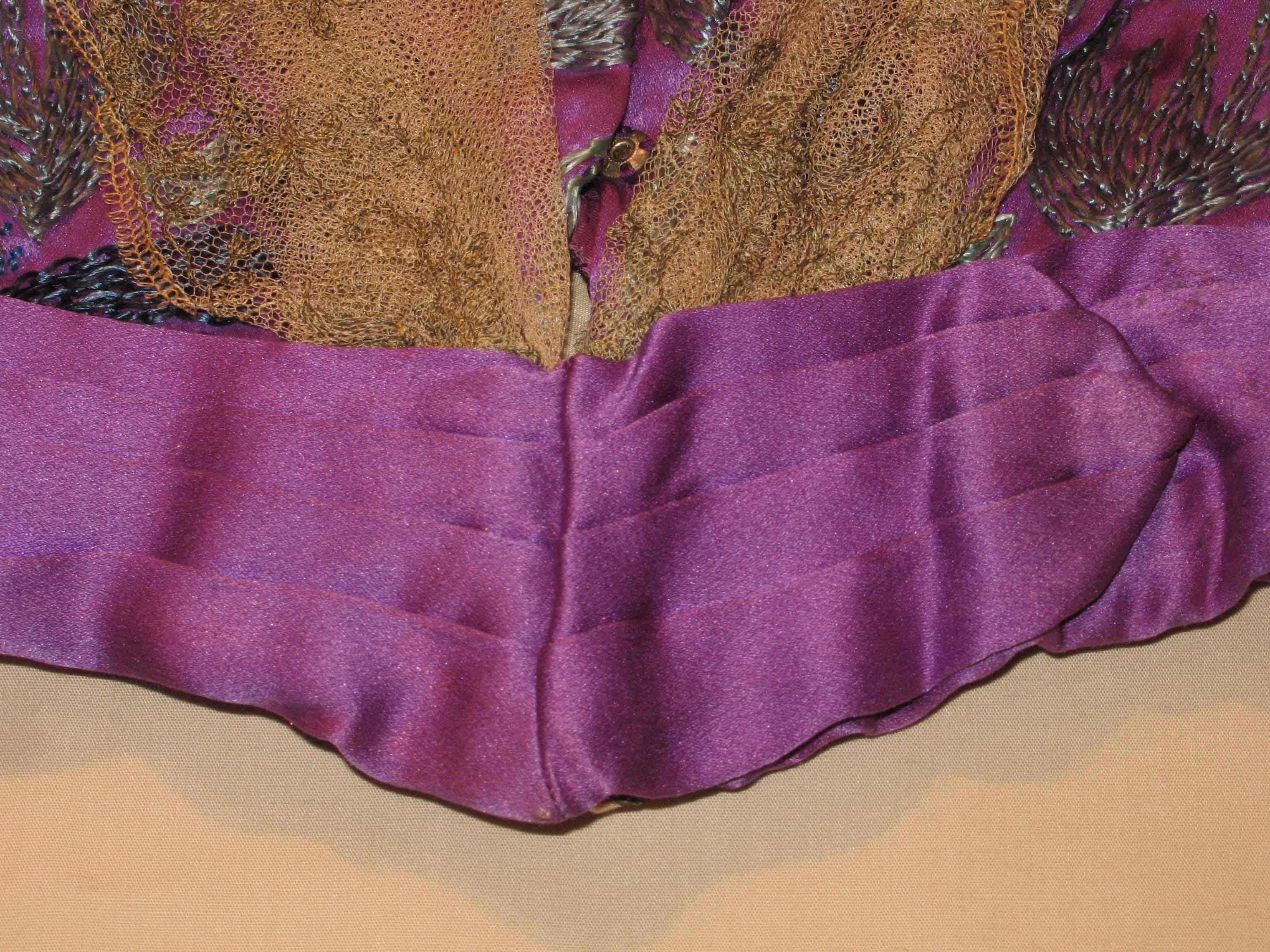 |
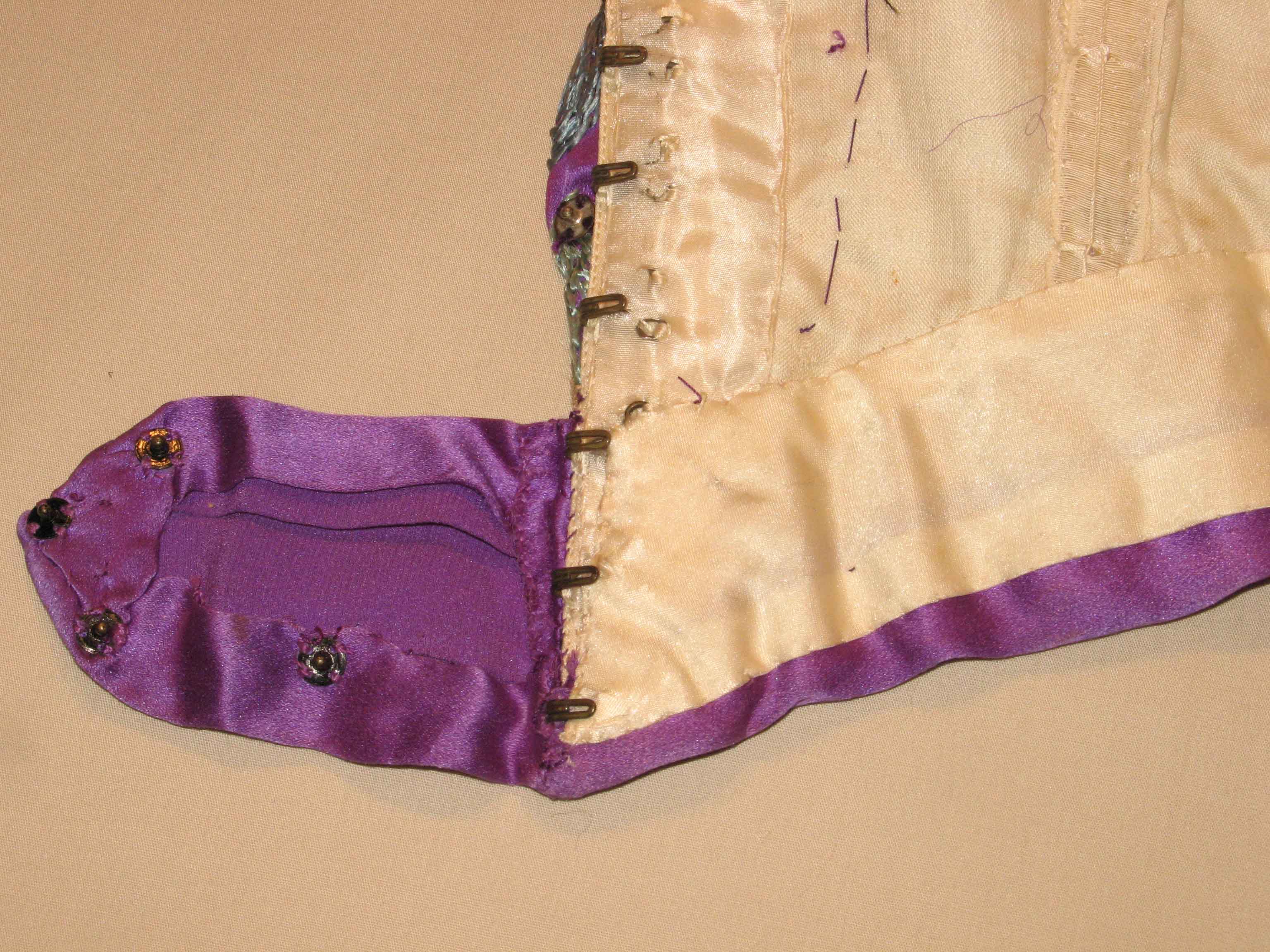 |
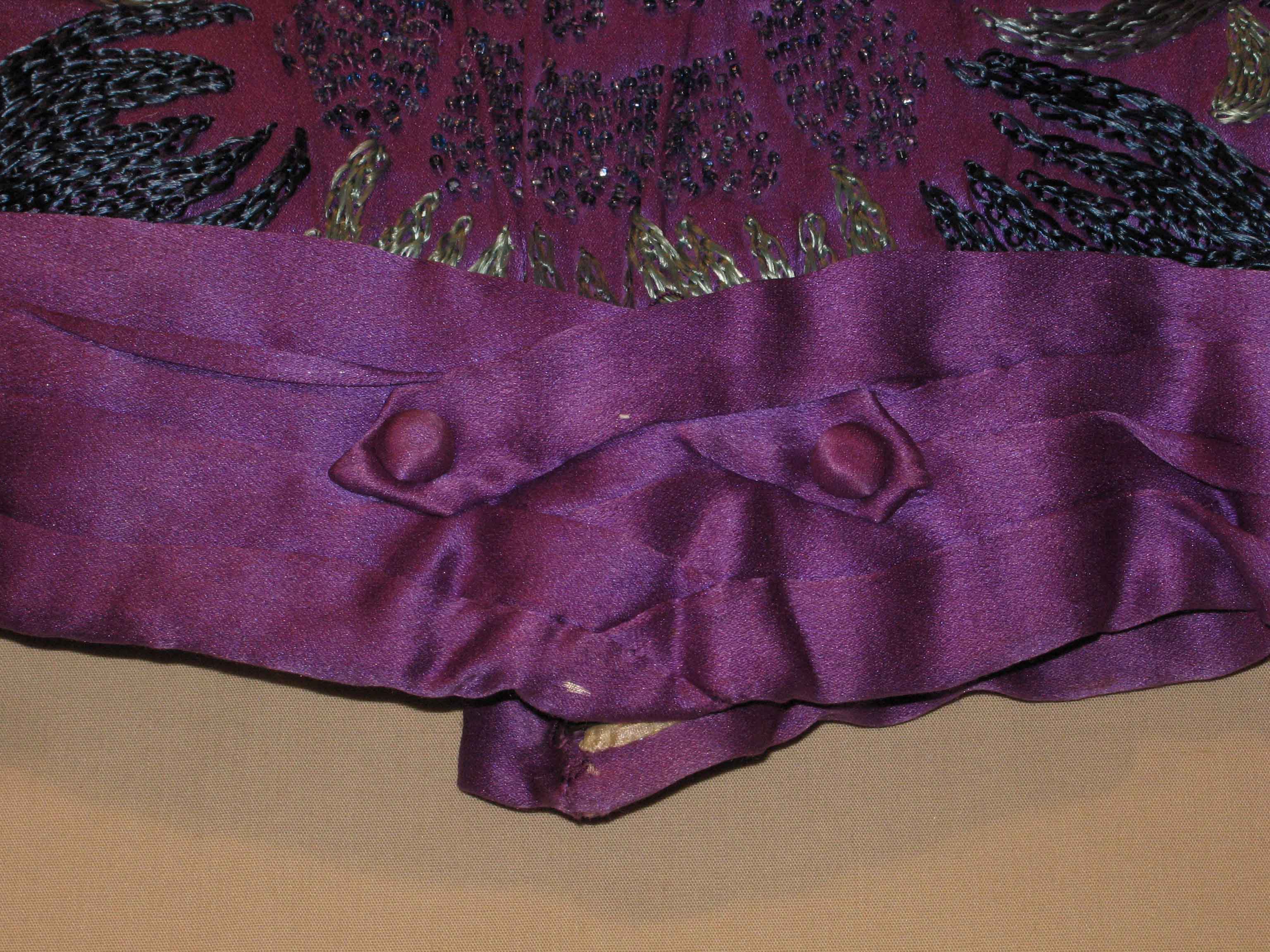 |
Bobbin Lace Fichu
The embroidered silk tulle fichu measures 10 1/2" wide. The top edge is turned 1/4" twice and pressed. It is folded into small random pleats on the center front pieces, finishing 1 1/4" wide, turned 1/4" at the hem and whip stitched along the edges. This pleated section is running stitched to the belt 2" above the hem. The fichu is also tacked into pleats at the intersection of the yoke and outer bodice. It follows the neckline, being tacked every so often, to the "V" center back where it is tacked in folds to miter and mirror the other side.
Figure 20: Fichu |
Figure 21: Fichu at Shoulder |
Figure 22: Fuchu at Front |
 |
 |
 |
© Emily N. VanDorvort Mason Heilig, 2008


